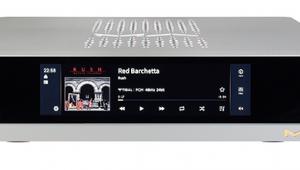Roon Nucleus+ network audio library Page 2
The effect of being enveloped in the original, unreleased multichannel recording of Pink Floyd’s Dark Side Of The Moon was suitably nostalgic, and the Nucleus+ allowed the Onkyo/Naim/PMC hybrid system to wrap the sound around the room, while still delivering serious bass punch and huge amounts of detail. Even more thrilling were some of 2L’s ‘in the round’ classical music recordings in hi-res DSD multichannel, where the use of the surround channels merely to add ambience is striking even in an ostensibly simple recording such as Ning Feng’s set of Bach Sonatas And Partitas For Solo Violin [Channel Classics CCS 39018; multichannel DSD64/128/256]. Remarkably, the three-dimensional sound has the effect of concentrating the mind on performance, rather than distracting from it – maybe it’s just that the ambience seems more ‘natural’ than with a ‘front-only’ stereo picture.
Optimised Platform
A key benefit of the dedicated Nucleus approach is its rock-solid operation – Roon software running on multipurpose devices can be prone to (very occasional) pauses when the computer in question is working hard doing other things. So perhaps I can, after all, answer that question about how the Nucleus+ sounds – simply, it’s one of the most convincing digital ‘transports’ I have used, delivering more of the music than the best of the computer sources I have encountered.

Maybe that’s no surprise, since what we have here is a computer dedicated to a single task – as indeed I have tried to do with my own ‘music Mac mini’ by removing all software, and ripping out all the hardware, not immediately related to playing music. The little Mac uses an SSD and expanded RAM, has an improved power supply, does without its wireless capability even to the point of having the antennae removed, and even sits on some isolating feet when I’m trying to work out whether or not they actually make any difference.
The Nucleus does much the same, but then goes further with its fanless design, lightweight operating system, lack of graphics output, and hefty casework – so really everything is in place for it to offer an optimised platform for audio playback.
Although I tend to take a ‘light touch’ approach to the various DSP functions Roon offers, some of them can be remarkably effective. Even in my desktop system, which uses an Asus Tinkerboard via a Gustard U12 digital interface into a first-gen NaimUniti powering Neat Iota speakers, it was surprising how much difference to the image was made by applying the tiniest of delays to one of the two speakers to compensate for marginally different distances between them and my ears. Meanwhile, a small amount of crossfeed between the speakers also had some interesting effects on the soundstaging – yes, I know it’s meant for headphones, but...
I have to admit I approached the Nucleus+ with some degree of cynicism – after all, it’s just an expensive way of buying a computer running Roon, isn’t it? – but I came away a convert, having spent an enjoyable time experimenting with this supposedly ‘tinker-proof’ concept. It may be ‘plug and play’, but the level of performance available – and the amount of experimentation allowed by the software – means that it will keep Roon users out of mischief for a very long while.
Hi-Fi News Verdict
The sound quality rating is more indicative of what the Nucleus+ doesn’t do than what it does, as it offers a solid platform on which your chosen DAC can strut its stuff. Its combination of style, joined-up thinking and sheer user appeal makes this an intriguing addition to any ‘computer audio’ system. It’s as easy to use as Roon implies, the software is extremely clever and it’ll add immeasurably to your listening experience.























































